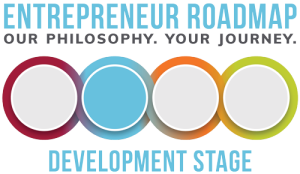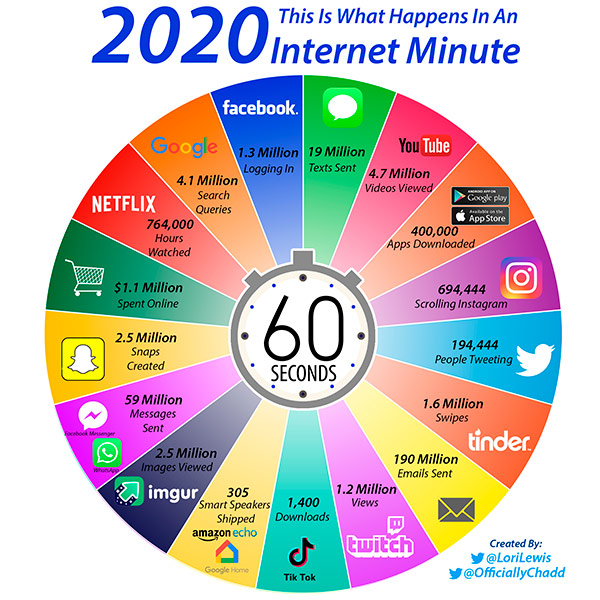Engagement Is A Trip, Plan Wisely

 As you move from the Development stage of product build into the Launch stage of the Entrepreneur Roadmap, you are going to find yourself making the sharp turn from inwardly-focused activities to rapid dives into marketing and demand generation. You’ll know you’re making this turn on your path when you find yourself caught up in endless useless facts like the Internet Minute, struggling to figure out how this fits with where you need to go.
As you move from the Development stage of product build into the Launch stage of the Entrepreneur Roadmap, you are going to find yourself making the sharp turn from inwardly-focused activities to rapid dives into marketing and demand generation. You’ll know you’re making this turn on your path when you find yourself caught up in endless useless facts like the Internet Minute, struggling to figure out how this fits with where you need to go.
While it’s been around for years, the annual Internet Minute graphic is always a fun read. It’s boggling to see how year over year volumes change, channels ebb and flow, with the one constant of ever-increasing volume.
 Think about all the different ways people interact – swipes, tweets, posts, snaps, scrolls…it can turn into a bit of a blur and create huge challenges for a new company. Let’s take advantage of all social channels! We can dominate TikTok! How do we go viral? How many likes can we get? The list can easily become endless and that’s a huge problem.
Think about all the different ways people interact – swipes, tweets, posts, snaps, scrolls…it can turn into a bit of a blur and create huge challenges for a new company. Let’s take advantage of all social channels! We can dominate TikTok! How do we go viral? How many likes can we get? The list can easily become endless and that’s a huge problem.
When starting a company, less is more. While the instinct to land and expand on every potential medium is natural, success will only come if you start with the lens of your prospective customer. While there are functions that will be uniform to all – website, LinkedIn Page, Google my Business, you’ll find that there is a rapid shift into very specific needs that are highly relevant to your market. Your challenge as a business is to understand what those channels are, and what their priority is to your prospects. Simply stated, identify the most important channels and cultivate.
Destination, vehicle, fuel
A large portion of the Ideation sprint in building a company and product is understanding the problems your customers face, then building a solution that solves that problem. As part of your discovery, you should have identified key facets of the buying process including where your customers learn about products or search for solutions. These interaction points create the foundation for your engagement channels and will help you prioritize where you need to be ready to interact with the public. Some are going to be intuitive, like a website, LinkedIn page, and twitter handle. Others will depend on the type of solution you are building and customer preference. If your final destination is a sale, then you should view the channels you use to interact with your customers as a vehicle. The content you put into that vehicle is what will get you to your end destination. Some trips only require one mode of transport, whereas others require multiple. This is what you need to map out. The more you understand the path to get to your destination, the easier it will be to move things along.
By taking this structured view, it will be easier for you to build your view of an internet minute based on the channels most important to your customers. Once you identify your channels you’ll be prepared to build out greater detail on your content strategy, communication templates for responses, tracking needs and measurement strategy to evaluate what does and does not work. By starting with an understanding of channels first, it is easier to adjust how you talk to people based on the venue.
As much as things change, they stay the same
As you warm up your channels and interaction you’ll quickly see what does and doesn’t work. Creating a very simple list of metrics to track engagement will help calibrate that insight. If we play out the destination metaphor, you’ll find that multiple paths can get you to the same place, but some are more efficient. Measurement will help you figure out those paths and optimize for the quickest, least expensive channels with the highest value. Ultimately, you may find that you don’t need as many channels as you originally mapped out, or you may have the right mix out of the gate. The key is to validate and ensure what you are pushing out is what your customers and prospects need. Business-to-business plays will have a different mix and engagement process than business-to-consumer products and will most likely be slower to expand but more complex to evolve. Conversely, consumer channels move quickly and are often quicker to prove results but take longer to break through given the volume. By sticking with that list of key metrics, you’ll stay aligned with what does and doesn’t work, just know that you must be patient as they prove themselves out.
Remember – Customers AND Prospects
My final, parting thought for you is short and a bit provocative. It’s not customers or prospects, it’s customers AND prospects. There aren’t discreet interaction channels for each, which means that the information you put out will be consumed by both. In a perfect world, you have an amazing Product-Market-Fit and your customers are vocal advocates on your behalf. Strong engagement channels create an opportunity for them to advocate to prospects on your behalf. Additionally, having consistent engagement so that the conversion from prospect to customer doesn’t feel disjointed and there’s no disillusionment in the conversion process.
Have questions on how to map out your engagement channels as part of your go-to-market strategy? Please reach out, we’d love to chat and learn more.
